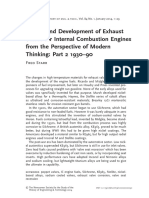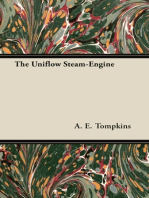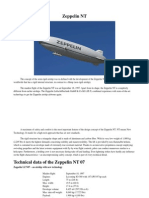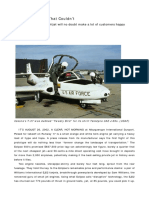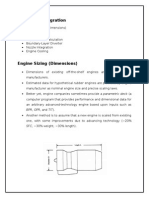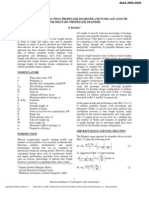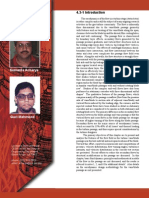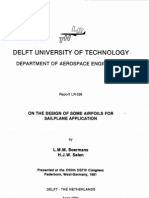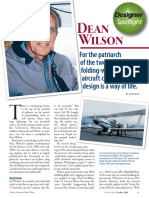Napier Nomad - Flight (1954) - 1
Napier Nomad - Flight (1954) - 1
Uploaded by
migss1074Copyright:
Available Formats
Napier Nomad - Flight (1954) - 1
Napier Nomad - Flight (1954) - 1
Uploaded by
migss1074Copyright
Available Formats
Share this document
Did you find this document useful?
Is this content inappropriate?
Copyright:
Available Formats
Napier Nomad - Flight (1954) - 1
Napier Nomad - Flight (1954) - 1
Uploaded by
migss1074Copyright:
Available Formats
FLIGHT, 30 April 1954
543
NAPIER NOMAD
An Engine of Outstanding Efficiency
STUDY of the development of aero engines during the past fifty years brings to light the rather remarkable fact that, whereas immense strides have been made in improving power/weight ratio, overhaul life and reliability, comparatively little has been done to improve thermal efficiency or specific fuel-consumption. Today, in fact, piston engines are scarcely 20 per cent better in these respects than they were in the 1914-18 war. The advent of gas-turbine power has not materially affected the overall position; while accelerating the improvement of power/weight ratios and holding forth promise of very good trouble-free life in the years to come, the gas turbine has made little contribution towards overall efficiencyin fart, the earliest turbojets were, in this respect, decidedly retrograde. This seeming lack of progress is by no means due to want of effort. The need for increased efficiency has always been clear enough, and is today of transcendent importance both to the military logistics planner and to the airline operator. To some extent, also, better power-unit efficiency is desirable to permit increased aircraft range or duration. But every engineer or company that has set out to achieve a significant improvement in fuel consumption has, sooner or later, given up the unequal struggle against weight, complexity and unreliability. Without going too deeply into thermodynamics, it may be said that the basic aim of the engine designer is roughly as follows : the working fluid (air, or hot gas, in aero engines) should initially be as cold as possible; it is then compressed as much as is practicable, in an adiabatic manner, so that heat losses are minimized; finally it is expanded and cooled as nearly as possible back to its original condition, and is made to do useful work during the latter pan of the cycle. The relatively poor efficiency of most aero engines results from insufficient compression and expansion ratio, and insufficient cooling of the working fluid before expulsion back to atmosphere; even in highly boosted engines with adequate peak temperatures and pressures, the exhaust is discarded while still very hot and at high pressure. At full throttle, about three-quarters of the heat energy originally released by burning the fuel is wasted by reason of the fact that the exhaust is released too soon. Innumerable methods have been adopted to reduce such
waste. Accepting an inefficient power unit as a fan accompli, some improvement can be made by employing ejector exhauststacks or, better, by extracting some of the exhaust energy by inserting a turbine in the gas stream and turning the shaft power to good account, either by making it drive a supercharger or by gearing the rotor to the crankshaft. Alternatively, a fresh start can be made on an engine with a revised thermodynamic cycle, such as a compound engine, or a diesel unit, or a more complex affair with various compressors, heatexchangers and intercoolers. All these have been tried, but the insistent demands of installed weight, simplicity, low first cost and high reliability have been strong enough to confine the propulsion of aircraft to essentially simple engines, whether of the reciprocating or turbine type. Now, however, an engine has been developed which is likely to see wide service in both military and civil roles as a result of its unmatched efficiency; in fact, its overall efficiency is of an altogether higher order than that achieved by any other aero engine. Particularly remarkable is the fact that, in spite of this unrivalled economy, the engine is extremely competitive in all other parameters, including power/weight ratio, complexity, bulk, altitude performance, flexibility and control, and ease of installation. Further, it can burn a wide range of fuels (not only accepted aircraft fuels) and it is likely that its overhaul time, overall life and reliability will be of an exceptionally high order. This engine, the Napier Nomad, is the result of many years' development by a British company, D. Napier and Son, Ltd. From a technical standpoint it is one of the most interesting aero engines ever designed, and the narrative which follows is accordingly the most extensive engine description that we have ever published. The germ of the idea grew from an official specification of 1944-45 calling for a 6,000 h.p. engine; this was, of course, the size which might have been required had the war continued, and gas-turbine developmentespecially of shaftdrive engineswas still in its infancy. The specification was written around a four-stroke piston engine, but Napiers (with whom we may couple the name of Mr. E. E. Chatterton, B.Sc.(Eng.), M.I.Mech.E., F.R.Ae.S., now chief engineer of the piston-engine division) were studying the promise of a compound unit incorporating a two-stroke diesel engine.
You might also like
- Marketing Communications Touchpoints, Sharing and Disruption, 8th Edition (Great For Case Studies)Document804 pagesMarketing Communications Touchpoints, Sharing and Disruption, 8th Edition (Great For Case Studies)Linh LinhNo ratings yet
- ExhaustDocument29 pagesExhaustLuisNo ratings yet
- FLIGHTLINE® Series, Enhanced BD-5 KitsDocument1 pageFLIGHTLINE® Series, Enhanced BD-5 KitsMiguel Angel Ramirez Moreno0% (1)
- Jet EngineDocument14 pagesJet EngineعبداللهأحمدNo ratings yet
- Saga of Gas Turbines 1Document4 pagesSaga of Gas Turbines 1goddord0% (1)
- 1999 Kitfox IV Analysis Final VersionDocument9 pages1999 Kitfox IV Analysis Final VersionJoseph Lee100% (1)
- 134 Corby StarletDocument5 pages134 Corby StarletFrancisco SantosNo ratings yet
- Blevins Formulas For Natural Frequency and Mode Shape PDFDocument3 pagesBlevins Formulas For Natural Frequency and Mode Shape PDFRyan Fisher0% (1)
- A411726 - A Comparison of Gyroscope Digital Models For An Electro-Optical - Infrared Guided Missile SimulationDocument214 pagesA411726 - A Comparison of Gyroscope Digital Models For An Electro-Optical - Infrared Guided Missile Simulationrenatotorresa2803No ratings yet
- FLYER EurofoxDocument6 pagesFLYER EurofoxMashrekin HossainNo ratings yet
- The Exit Velocity of A Compressed Air Cannon3Document9 pagesThe Exit Velocity of A Compressed Air Cannon3tOLNo ratings yet
- Type Cert A718Document6 pagesType Cert A718skatterbrainkidNo ratings yet
- 1920 Metalsinaircraft00hanbrichDocument128 pages1920 Metalsinaircraft00hanbrichUlf Dunell100% (1)
- 73549-116619 - Takehiro Okura - Dec 17 2015 1027 Am - Asen 5063 2015 Final Report OkuraDocument14 pages73549-116619 - Takehiro Okura - Dec 17 2015 1027 Am - Asen 5063 2015 Final Report Okuraleel leelNo ratings yet
- Peter M. BowersDocument9 pagesPeter M. Bowersretread1100% (2)
- Altitude Performance Comparison of A Wankel enDocument6 pagesAltitude Performance Comparison of A Wankel enrudey18No ratings yet
- Electric, Hybrid and Turboelectric Fixed-Wing Aircraft - A Review of Concepts, Models and Design ApproachesDocument19 pagesElectric, Hybrid and Turboelectric Fixed-Wing Aircraft - A Review of Concepts, Models and Design Approachesdiotrab13100% (1)
- Hispano Suiza V8Document6 pagesHispano Suiza V8seafire47No ratings yet
- Improved Aeronca Engine: For Advanced Military TrainingDocument1 pageImproved Aeronca Engine: For Advanced Military Trainingseafire47No ratings yet
- Super Plastic FormingDocument2 pagesSuper Plastic FormingsibimsNo ratings yet
- The Design Development and Testing of A PDFDocument109 pagesThe Design Development and Testing of A PDFAnonymous p2vfijnNo ratings yet
- Calculation of Thrust in A Ducted Fan Assembly For HovercarftDocument14 pagesCalculation of Thrust in A Ducted Fan Assembly For HovercarftAndrew Whipple100% (2)
- A Survey of Research Performed at Nasa Langley Research Center's Impact Dynamics Research FacilityDocument19 pagesA Survey of Research Performed at Nasa Langley Research Center's Impact Dynamics Research FacilityГригорий ОмельченкоNo ratings yet
- WOW Jet Engines 2019 SDocument80 pagesWOW Jet Engines 2019 SHassan MoazenNo ratings yet
- The Role of Biaxial Stresses in Discriminating Between Meaningful and Illusory Composite Failure TheoriesDocument18 pagesThe Role of Biaxial Stresses in Discriminating Between Meaningful and Illusory Composite Failure Theorieskhudhayer1970No ratings yet
- Ruijgrok Flight Performance TocDocument5 pagesRuijgrok Flight Performance ToclarasmoyoNo ratings yet
- MAE 570 Aircraft Nozzles - SDocument23 pagesMAE 570 Aircraft Nozzles - SLuiz Felipe Disconzi LopesNo ratings yet
- Facts: High-Speed Research - The Tu-144LL: A Supersonic Flying LaboratoryDocument4 pagesFacts: High-Speed Research - The Tu-144LL: A Supersonic Flying LaboratoryNASAdocumentsNo ratings yet
- A50 JUNIOR Brochure EnglishDocument12 pagesA50 JUNIOR Brochure EnglishSaeid MirNo ratings yet
- Technical Data of The Zeppelin NT 07 PDFDocument8 pagesTechnical Data of The Zeppelin NT 07 PDFVishnoo PrathapNo ratings yet
- Chapter 48. Wing in Ground (WIG) CraftDocument23 pagesChapter 48. Wing in Ground (WIG) CraftThiago BentoNo ratings yet
- 2018 Hartzell Propeller Price ListDocument96 pages2018 Hartzell Propeller Price ListoscarNo ratings yet
- Rameez - Ducted Fans Vs PropellersDocument2 pagesRameez - Ducted Fans Vs PropellersRameez Ul HaqNo ratings yet
- Eta (Glider) - WikipediaDocument2 pagesEta (Glider) - Wikipediajordanfakes.psdNo ratings yet
- The Gyroplane Breguet, Louis - (1937)Document36 pagesThe Gyroplane Breguet, Louis - (1937)Mariela Tissera100% (1)
- LOM Praha Piston EnginesDocument9 pagesLOM Praha Piston EnginesRainer NybergNo ratings yet
- Summary of Propeller Design Procedures and Data - Vol IIDocument379 pagesSummary of Propeller Design Procedures and Data - Vol IIasdalfNo ratings yet
- The Little Engine That CouldnDocument8 pagesThe Little Engine That CouldnMorgen Gump100% (1)
- Jet Engine IntegrationDocument8 pagesJet Engine IntegrationZeeshan100% (1)
- Advanced Design Studies and Unusual Concepts FLIYNG BOATSDocument2 pagesAdvanced Design Studies and Unusual Concepts FLIYNG BOATSviorelu99No ratings yet
- GE Gas Turbine Engine Technology Evolution & History: Oluwatosin OkuwobiDocument11 pagesGE Gas Turbine Engine Technology Evolution & History: Oluwatosin OkuwobiVishnu RamNo ratings yet
- Superior Uav - 2003Document6 pagesSuperior Uav - 2003SivaramanNo ratings yet
- Selecting Fuel Fraction, Propeller Diameter and Fuselage Length For Military Propeller TrainersDocument9 pagesSelecting Fuel Fraction, Propeller Diameter and Fuselage Length For Military Propeller TrainersIbrahim KNo ratings yet
- Datasheet F414 EnhancedDocument2 pagesDatasheet F414 EnhancedMohamed AzeamNo ratings yet
- Ostiv Book Long FinalDocument126 pagesOstiv Book Long FinalkurionNo ratings yet
- Turbine Blade AerodynamicsDocument28 pagesTurbine Blade AerodynamicsFahim KhanNo ratings yet
- TL 3.17 List of Approved Prototype Mods PDFDocument143 pagesTL 3.17 List of Approved Prototype Mods PDFomid omidiNo ratings yet
- C-130 Hercules: Instruction Manual Semi Scale Model of The World Famous Military Transport AircraftDocument19 pagesC-130 Hercules: Instruction Manual Semi Scale Model of The World Famous Military Transport AircraftTom PymNo ratings yet
- LR 326 1Document49 pagesLR 326 1RAHULNo ratings yet
- Scottish RotorDocument8 pagesScottish Rotoraravisara5100% (1)
- AC - 65-2D Airframe &powerplantDocument65 pagesAC - 65-2D Airframe &powerplantSal StNo ratings yet
- Dean WilsonDocument7 pagesDean WilsonMB-RP100% (1)
- MasterDocument525 pagesMasterؤآللهہ حہبہيہتہكہNo ratings yet
- CSVLADocument122 pagesCSVLAcorticalisNo ratings yet
- 达索公司catia飞机设计教程Document3 pages达索公司catia飞机设计教程bb06412000100% (1)
- Vehicle Aerodynamics KTH1Total PDFDocument55 pagesVehicle Aerodynamics KTH1Total PDFMarcos SoarNo ratings yet
- JEM0001-2 Overhaul ManualDocument196 pagesJEM0001-2 Overhaul ManualRicardo UrioNo ratings yet
- Burevestnik-24 - Presentation - EnglDocument30 pagesBurevestnik-24 - Presentation - EnglschrobsNo ratings yet
- Jetcat P60 / P70 / P80 / P120 / P180 / P160 / P200: Instruction ManualDocument53 pagesJetcat P60 / P70 / P80 / P120 / P180 / P160 / P200: Instruction ManualEyeFlyNo ratings yet
- Aircraft Down: Forced Landings, Crash Landings and RescuesFrom EverandAircraft Down: Forced Landings, Crash Landings and RescuesRating: 3 out of 5 stars3/5 (1)
- The Revisionist 2003 No 3 Murder of Rachel Corrie, A War Conceived in Israel, Partisan Warfare During WWIIDocument122 pagesThe Revisionist 2003 No 3 Murder of Rachel Corrie, A War Conceived in Israel, Partisan Warfare During WWIImigss1074No ratings yet
- The Revisionist 2003 No 3 9 11 Arab or Government Iraq Israel Murders Cover Up Gypsies Auschwitz Foreign Workers 3Rd Reich Partisan Wwii HolohoaxDocument122 pagesThe Revisionist 2003 No 3 9 11 Arab or Government Iraq Israel Murders Cover Up Gypsies Auschwitz Foreign Workers 3Rd Reich Partisan Wwii Holohoaxmigss1074No ratings yet
- The Revisionist - Journal For Critical Historical Inquiry - Volume 2 - Number 2 (En, 2004, 122 S., Text)Document122 pagesThe Revisionist - Journal For Critical Historical Inquiry - Volume 2 - Number 2 (En, 2004, 122 S., Text)hjuinix100% (1)
- Vibrations of Rifle Barrels - Mallock (January 1, 1901)Document18 pagesVibrations of Rifle Barrels - Mallock (January 1, 1901)migss1074No ratings yet
- The Revisionist - 2003 No. 1Document122 pagesThe Revisionist - 2003 No. 1migss1074No ratings yet
- HFFH Himmler S Files From Hallein USA 1945Document38 pagesHFFH Himmler S Files From Hallein USA 1945migss1074No ratings yet
- Armour and Its Attack by Artillery - Browne (1887)Document330 pagesArmour and Its Attack by Artillery - Browne (1887)migss1074100% (1)
- A Diagram To Facilitate The Study of External Ballistics - Dalby (April 1, 1916)Document14 pagesA Diagram To Facilitate The Study of External Ballistics - Dalby (April 1, 1916)migss1074No ratings yet
- Field Fortification A Study of The Western Front in Europe USA 1916Document104 pagesField Fortification A Study of The Western Front in Europe USA 1916migss1074No ratings yet
- Gruson's Chilled Cast-Iron Armour - Schütz (1887)Document158 pagesGruson's Chilled Cast-Iron Armour - Schütz (1887)migss1074No ratings yet
- The Steam Engine - Its History and Mechanisms - Scott (1854)Document216 pagesThe Steam Engine - Its History and Mechanisms - Scott (1854)migss1074No ratings yet
- DIY Plans - Model Steam Marine EngineDocument5 pagesDIY Plans - Model Steam Marine Enginemigss107483% (6)
- Iim-Bodh Gaya - Mba Pi Kit - 2022 - AdcomDocument90 pagesIim-Bodh Gaya - Mba Pi Kit - 2022 - AdcomAncient SurferNo ratings yet
- Brochure A60h t4f en 22 Voe2260009418-ADocument13 pagesBrochure A60h t4f en 22 Voe2260009418-AamelNo ratings yet
- The International Temperature Scale of 1990Document9 pagesThe International Temperature Scale of 1990xhmikosNo ratings yet
- Man v48 60crDocument2 pagesMan v48 60crmargarita margaNo ratings yet
- Talent Factor in PurchasingDocument14 pagesTalent Factor in PurchasingavinashagriNo ratings yet
- Gate - 1990Document11 pagesGate - 1990mribiiNo ratings yet
- Integrated Wellbore Assurance FlowchartDocument1 pageIntegrated Wellbore Assurance FlowchartLoganBohannonNo ratings yet
- Utilizing Waste Coconut Fibers and Rice Husk Ash As Aggregates in Mix Proportioning of Concrete Hollow BlocksDocument44 pagesUtilizing Waste Coconut Fibers and Rice Husk Ash As Aggregates in Mix Proportioning of Concrete Hollow BlocksDianna GwennNo ratings yet
- Jeanine Avalos Resume 2Document2 pagesJeanine Avalos Resume 2api-644273888No ratings yet
- Mcob 1st ModuleDocument33 pagesMcob 1st ModuleAarcha SreedevNo ratings yet
- What Is Price Skimming?: First MoverDocument9 pagesWhat Is Price Skimming?: First MoverDiya MukherjeeNo ratings yet
- Cooling TowersDocument24 pagesCooling TowersMiahsaheb RafeeqNo ratings yet
- Syllabus On Human Computer InteractionDocument19 pagesSyllabus On Human Computer InteractionCHERYL A. EBAJONo ratings yet
- ICAO SMS Course Outline 2008Document10 pagesICAO SMS Course Outline 2008eliasox123No ratings yet
- Monitoring Technique: Thermistor Motor Protection Relay Ba 9038, Ai 938 VarimeterDocument2 pagesMonitoring Technique: Thermistor Motor Protection Relay Ba 9038, Ai 938 VarimeterDan StroescuNo ratings yet
- Thesis 17 Wordpress ThemeDocument6 pagesThesis 17 Wordpress Themejillcrawfordbaltimore100% (2)
- Centre Wise CPI IW DEC 2023Document1 pageCentre Wise CPI IW DEC 2023Jandu MaharashtraNo ratings yet
- CW-Fifth Admission List - L.L.B.-2021Document3 pagesCW-Fifth Admission List - L.L.B.-2021Sushil ShuklaNo ratings yet
- Historial de Exámenes para NATHANIEL ALEJANDRO YANEZ PULGARIN - Examen Parcial - Semana 4Document14 pagesHistorial de Exámenes para NATHANIEL ALEJANDRO YANEZ PULGARIN - Examen Parcial - Semana 4Alejandro YanezNo ratings yet
- Deep Neural Network Solution of The Electronic Schrödinger EquationDocument11 pagesDeep Neural Network Solution of The Electronic Schrödinger EquationMarcos OliveiraNo ratings yet
- Corolla SedanDocument1 pageCorolla SedanSolanum tuberosumNo ratings yet
- Mango, The Turkish ModelDocument33 pagesMango, The Turkish ModelBenjamin AlexanderNo ratings yet
- Resume Format Word Mac 2008Document7 pagesResume Format Word Mac 2008gt2fmfzh100% (1)
- BT3000 PLUS Service-Manual ING Rev.0-Ver.8!05!10-04Document184 pagesBT3000 PLUS Service-Manual ING Rev.0-Ver.8!05!10-04Lucas Janiares50% (2)
- Panel FV LG-295-300m - 1686x1016x40 - 1000 - enDocument4 pagesPanel FV LG-295-300m - 1686x1016x40 - 1000 - enjhonathanNo ratings yet
- CISA TIC 3.0 Program Guidebook v1.1Document29 pagesCISA TIC 3.0 Program Guidebook v1.1Ryan HowardNo ratings yet
- Chapter 1158Document35 pagesChapter 1158RobertKimtaiNo ratings yet
- Unit 1 Gerontological Nursing 2Document26 pagesUnit 1 Gerontological Nursing 2az900231No ratings yet

